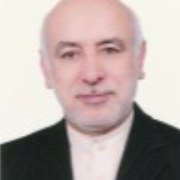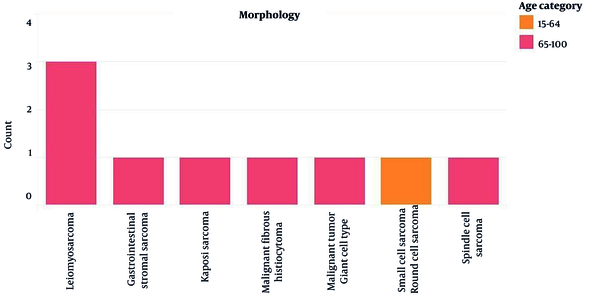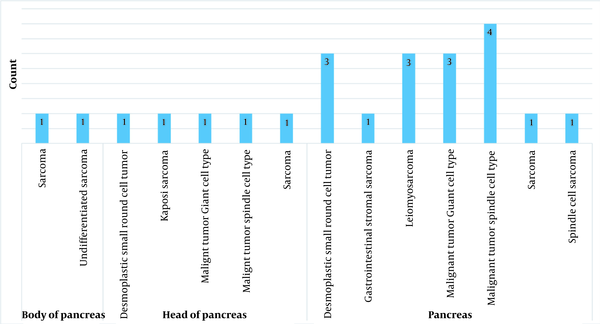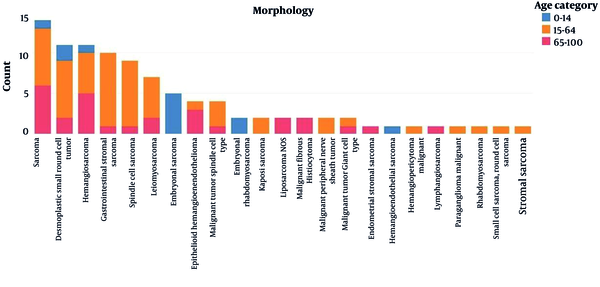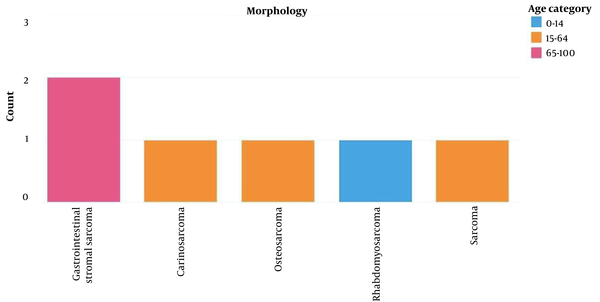1. Background
Hepatopancreatobiliary (HPB) sarcomas are uncommon types of malignancy that usually have a poor prognosis (1, 2). Primary sarcomas of the pancreatic region are even rarer with a worse prognosis because of a delayed diagnosis (3, 4). Due to some progression in genomic sequence findings in these malignancies, new data has been developed regarding their molecular arrangement (5, 6). Amongst pancreatic sarcoma subtypes, leiomyosarcoma has been the most frequently reported one, but in other biliary sarcomas, there are different subtypes with varied prognoses and courses (7-9).
Hepatopancreatobiliary sarcoma cases usually present as obstructive jaundice with increased bilirubin and liver enzyme levels (10). Despite the fact that this presentation might assist in earlier diagnosis, it usually occurs when the tumor is at late stages with a short survival period (11, 12). The diagnosis of HPB sarcoma is usually made by non-invasive imaging modalities such as ultrasound, magnetic resonance imaging, computed tomography, and occasionally invasively endoscopic retrograde cholangiopancreatography (13, 14). Acknowledgment of the clinical subtypes, patterns, and main characteristics may prompt diagnosis and treatment. Hence in this study, the epidemiological characteristics of cases with HPB sarcoma among Iranian patients were assessed to report the incidence patterns of HPB in Iran from 2010 to 2014, according to available data.
2. Methods
This epidemiological study assessed 133 cases of HPB sarcoma in Iran, from 2010 - 2014. These included the gallbladder, pancreatic head, pancreatic body, hepatic, pancreatic, and other biliary tract sites. Age, sex, anatomical location, province, and year were the main variables extracted from existing medical data based on stratified sampling. Data were obtained from the National Population-based Study in Iran National Cancer Registry (INCR) dataset by Ebrahimpour et al. (15).
The study protocol comprised data extraction and quality assurance. The former included duplicate removal, which was assessed by patient identity and cancer report. The latter consisted of tumor assessment by age, sex, morphology, diagnostic method, province of residence, and date of disease development. The Cali Cancer Registry Method was used to identify sarcoma cases in which death certificate only (DCO) indicating cases their selection was made by death certificate report. For the patients for whom DCO was the basis of selection, in case additional data on clinical or pathological diagnostic reports were available, they were considered; otherwise, DCO was accepted as the primary source. For Dcn and DcI, no effort was made. The recorded data in the Iranian Health Ministry were rechecked twice by blinded subjects.
Data analysis was done by Excel software. No comparative assessment was performed in this study. Only epidemiological data are presented. Also, numerical data such as age were converted to categorical ones for better presentation.
The Ethics Committee of Shahid Beheshti University of Medical Sciences approved this study.
3. Results
3.1. General Characteristics
Out of 133 cases with HPB sarcoma, 61 cases were female, and 72 were male (F/M ratio: 0.84). The highest incidence rate was reported in the age category of 15 to 64 years with 73 (54.8 %) cases, following the older age category (> 65 years) with 47 (35%) patients. The least incidence rate was observed in 14 years and younger group with 13 (< 10%). The gender distribution similarity observed in the two younger groups was shifted toward men in the 65 and older group, showing a virtually two-fold incidence rate in men compared to women. The annual distribution of cases was lowest in 2010 accounting for only 5% of all cases, which increased to 24% and maintained during the following years except for a 3% fall in 2013. Nineteen percent of cases occurred in the capital city of Tehran, following Isfahan and Fars with 10%.
3.2. Gallbladder
A total of 9 gallbladder sarcoma cases were reported between 2010 to 2014, accounting for 6.7% of all cases with HPB sarcoma. The incidence rate gradually increased till 2013, reaching three patients and dropping to one case in 2014. Leiomyosarcoma was the most common type (Figure 1). Aside from one case, they were in the age range of over 65 years. The youngest case was seen in Tehran in 2014. The other patients were seen in Isfahan and Tabriz. As shown in Table 1, three cases were reported in Tehran generally. Cases were equally distributed among men and women.
| Origin of Tumor | 2010 | 2011 | 2012 | 2013 | 2014 |
|---|---|---|---|---|---|
| Gallbladder | 1 | 1 | 2 | 3 | 2 |
| Tehran | 1 | 1 | 0 | 0 | 1 |
| Isfahan | 0 | 0 | 1 | 1 | 0 |
| Others | 0 | 0 | 1 | 2 | 1 |
| Pancreas | 1 | 6 | 3 | 2 | 4 |
| Tehran | 0 | 1 | 1 | 1 | 0 |
| Isfahan | 0 | 2 | 0 | 0 | 0 |
| Others | 1 | 3 | 2 | 1 | 4 |
| Liver | 4 | 16 | 23 | 17 | 23 |
| Tehran | 1 | 4 | 5 | 3 | 5 |
| Isfahan | 0 | 1 | 5 | 2 | 0 |
| Others | 3 | 11 | 13 | 12 | 18 |
| Pancreas head | 1 | 2 | 1 | 2 | 0 |
| Tehran | 0 | 0 | 0 | 1 | 0 |
| Isfahan | 0 | 0 | 0 | 0 | 0 |
| Others | 1 | 2 | 1 | 1 | 0 |
| Pancreas body | 0 | 0 | 0 | 0 | 2 |
| Tehran | 0 | 0 | 0 | 0 | 0 |
| Isfahan | 0 | 0 | 0 | 0 | 1 |
| Others | 0 | 0 | 0 | 0 | 1 |
| Other biliary sites | 0 | 2 | 2 | 1 | 1 |
| Tehran | 0 | 0 | 0 | 0 | 0 |
| Isfahan | 0 | 0 | 0 | 0 | 0 |
| Others | 0 | 2 | 2 | 1 | 1 |
Total Data for Year and Initial Province of All Tumors
3.3. Pancreas
Sixteen cases of pancreatic origin were reported during this period, with the highest rate of 6 cases in 2011 and 1 to 4 cases in the other years. Malignant type spindle cell tumor was the most common type accounting for 12.5% of all cases (Figure 2). The majority (69%) of cases were between 15 - 64 years old, whereas the rest were older than 65 (31%). The female/male incidence ratio was 6/10. As shown in Table 1, three cases were from Tehran.
3.4. Pancreas Head
Five cases of pancreatic head sarcoma were reported during 2010 - 2013. There was no predominant tumor type (Figure 2). The incidence was slightly higher in the ages older than 65. As shown in Table 1, only one case was from Tehran. The female-to-male ratio was 0.66.
3.5. Pancreatic Body
A total of two cases were reported, both in 2014 and of different types. (Figure 2). Each was of a diverse age group. As noted in Table 1, no case was from Tehran province. There was one male and one female case.
3.6. Liver
Ninety-five cases of liver sarcomas were reported generally. Non-specified and desmoplastic small round cell tumors were the most common types (Figure 3). The highest incidence rate was observed in the age group of 15 to 64 years, accounting for 57% of all sarcomas of liver origin, while only 29% were above 65 years old. As shown in Table 1, 18 cases were from Tehran. The female-to-male ratio was 0.86.
3.7. Other Biliary Tract Sites
A total of 6 cases were reported. Gastrointestinal stromal sarcoma was the most common type (Figure 4). Half of the cases were in the age category of 15 to 64 years. As shown in Table 1, these cases were mainly from Khuzestan and Fars. The incidence rate in women and men was equal.
4. Discussion
Biliary sarcomas typically present with obstructive jaundice by the tumor pressure effect, occasionally accompanied by hepatomegaly and sometimes abdominal distention (10). Also, elevated serum levels of conjugated bilirubin and liver enzymes are seen in the majority of patients. Hence in subjects older than 65 years with such symptoms, further caution should be taken. Other less common clinical findings include nausea, vomiting, abdominal pain, and fever (16, 17).
The most common site of HPB sarcoma was of liver origin, accounting for 71% of total cases, followed by sarcomas of pancreatic origin with 16%. The least commonly reported site was the pancreatic body comprising less than 2%. The female-to-male ratio varied from 0.6 to 1.25 in different tumor sites with an average of 0.84 generally.
The demographics of HPB sarcoma were similar to previous studies, with the majority occurring in middle-aged women, meaning women aged 15 to 64 were predominant in our findings (18, 19).
A study by Husain et al. (20) among seven biliary sarcomas in the United Kingdom and Austria showed that there were one male and six females with a median age of 70 years. There was no significant difference between men and women in our study. Altekruse et al. (21) showed that during a period of five years, the leading histological groups were hepatocellular carcinoma (75%) and cholangiocarcinoma (12%). The remaining categories were other specified (3%) and poorly specified carcinomas (3%), hepatoblastomas (1%), sarcomas (1%), embryonal sarcomas (0.1%), other specified malignancies (0.05%), and poorly specified malignancies (5%). The rate of sarcoma was so low that a detailed assessment was impossible. In line with these findings, Matthaei et al. reported sarcomas of biliary origin constituting less than 2% of liver malignancies (22).
Treatment of patients with HPB malignancy is yet challenging, and the strategy has largely been extrapolated from the knowledge in the treatment of cholangiocarcinoma, with resection of the tumor as the mainstay of therapy (17, 23). But in pancreatic cancers, mainly due to worse prognosis, some conservative approaches may also be considered for treatment in patients (24, 25). As the main limitation in of study, the prognosis and outcome in patients were not assessed. Hence despite the assessment of background variables such as sex and age in this study, their prognostic role was not evaluated.
4.1. Conclusions
According to the obtained results in this study, it may be concluded that HPB sarcoma in the Iranian population generally has diverse types, and there are different patterns according to the age and sex distribution in patients according to the initial location of the tumor and also pathological subtypes in them. However, further studies with longitudinal follow-up are required to attain more definite results, especially about the prognosis and outcomes in the patients and contributing factors.

